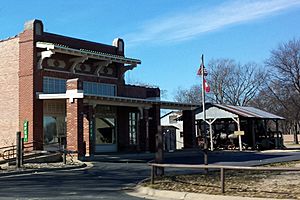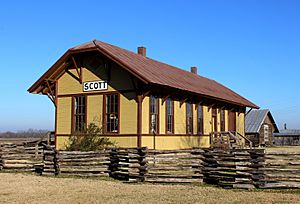Scott, Arkansas facts for kids
Quick facts for kids
Scott, Arkansas
|
|
|---|---|

Plantation Agriculture Museum operated by the Arkansas Department of Parks, Heritage and Tourism
|
|

Location in Lonoke County and the state of Arkansas
|
|
| Country | United States |
| State | Arkansas |
| Counties | Pulaski, Lonoke |
| Area | |
| • Total | 3.31 sq mi (8.57 km2) |
| • Land | 3.16 sq mi (8.19 km2) |
| • Water | 0.15 sq mi (0.38 km2) |
| Elevation | 243 ft (74 m) |
| Population
(2020)
|
|
| • Total | 97 |
| • Density | 30.67/sq mi (11.84/km2) |
| Time zone | UTC-6 (Central (CST)) |
| • Summer (DST) | UTC-5 (CDT) |
| ZIP code |
72142
|
| Area code(s) | 501 |
| FIPS code | 05-62900 |
| GNIS feature ID | 2402831 |
Scott is a small community in Arkansas, located in parts of Lonoke and Pulaski counties. In 2020, about 97 people lived there. It is considered part of the larger Little Rock area.
Contents
History of Scott
Ancient Cultures and Early Settlers
More than 1,000 years ago, a group of Native Americans called the Plum Bayou culture lived near what is now Scott. They built large mounds near Mound Pond between 650 and 1050 CE. These mounds are now protected as Plum Bayou Mounds Archeological State Park.
The Arkansas River created rich farmland in the area. This attracted early European settlers. Peter L. Lefevre and his family were among the first French settlers, arriving in 1818. Chester Ashley also bought land for farming in the early 1800s. The community of Scott is named after Conoway Scott Sr., who arrived in the 1830s.
Civil War Events in Scott
The Scott area saw some action during the American Civil War. In 1863, two Confederate generals, John S. Marmaduke and Lucius M. Walker, had a serious disagreement. This led to a duel where General Marmaduke wounded General Walker.
Another event was the Skirmish at Ashley's Mills in September 1863. Union troops fought Confederate soldiers here. The Union victory helped them clear the way to capture Little Rock.
Growth with the Railroad
The St. Louis Southwestern Railway, also known as the Cotton Belt Route, was built through Scott in 1871. A new train station, called Scott's Station, was built on Conoway Scott Sr.'s land.
In 1912, Conoway Scott Jr. built a large brick building for a general store. It later became Foster's General Store. A post office was added in 1929. Eventually, the community's name was shortened to Scott.
Geography of Scott
Scott is located in western Lonoke County and eastern Pulaski County. It is next to North Little Rock to the west. U.S. Route 165 goes through Scott, connecting it to Interstate 440 and other towns. Downtown Little Rock is about 12 miles west.
The area of Scott is about 3.3 square miles. Most of it is land, but about 0.15 square miles is water. Horseshoe Lake, which is an oxbow lake (a U-shaped lake formed when a river channel changes), is in the Pulaski County part of Scott. It was once a part of the Arkansas River.
Population and People
Scott is a small community. Here's how its population has changed:
| Historical population | |||
|---|---|---|---|
| Census | Pop. | %± | |
| 2000 | 94 | — | |
| 2010 | 72 | −23.4% | |
| 2020 | 97 | 34.7% | |
| U.S. Decennial Census 2010 2020 |
|||
Who Lives in Scott?
The table below shows the different groups of people living in Scott.
| Race / Ethnicity (NH = Non-Hispanic) | Pop 2010 | Pop 2020 | % 2010 | % 2020 |
|---|---|---|---|---|
| White alone (NH) | 37 | 51 | 51.39% | 52.58% |
| Black or African American alone (NH) | 30 | 29 | 41.67% | 29.90% |
| Native American or Alaska Native alone (NH) | 0 | 0 | 0.00% | 0.00% |
| Asian alone (NH) | 0 | 0 | 0.00% | 0.00% |
| Pacific Islander alone (NH) | 0 | 1 | 0.00% | 1.03% |
| Some Other Race alone (NH) | 0 | 0 | 0.00% | 0.00% |
| Mixed Race or Multi-Racial (NH) | 0 | 10 | 0.00% | 10.31% |
| Hispanic or Latino (any race) | 5 | 6 | 6.94% | 6.19% |
| Total | 72 | 97 | 100.00% | 100.00% |
Education in Scott
Scott is part of the Pulaski County Special School District. While the district doesn't have a school directly in Scott anymore, the old Scott Elementary School is now a charter school run by Academics Plus Charter Schools. It serves students from kindergarten to sixth grade.
Older students in Scott typically attend Harris Elementary School, Mills Middle School, and Wilbur D. Mills High School.
Places to Visit in Scott
Scott has several interesting places that tell its history.
- The Plantation Agriculture Museum shows what farming was like in Arkansas, especially cotton growing. It's in an old general store building and has a restored cotton gin.
- The Plum Bayou Mounds Archeological State Park protects the ancient mounds built by Native Americans almost 1,000 years ago. It's a very important historical site.
- The Scott Plantation Settlement has old buildings moved from different places to show what plantation life was like. This includes the old Cotton Belt Railroad Depot.
- Marlsgate Plantation, also known as the Dortch Plantation, is a beautiful old mansion built in 1904. It's now a popular place for weddings and events.
- Longbridge Plantation, also called the Charles Alexander House, is another historic estate. It was built around 1906 by Charles Newton Alexander, a very important landowner and businessman.
- Land's End Plantation (Scott, Arkansas) is a large working farm built in 1925. It has a unique Tudor Revival style house and many old farm buildings.
- The All Souls Church (Scott, Arkansas) is a beautiful old church built in 1906-1907. It's still used today and is listed on the National Register of Historic Places.
- Other historic homes in the area include the Fred and Lucy Alexander Schaer House, the Ashley-Alexander House, and The Cotham House.
- Charlotte's Eats and Treats in nearby Keo, Arkansas is famous for its delicious pies.
Notable People from Scott
- Catherine Tharp Altvater, a well-known artist, lived in Scott for the last ten years of her life.
See also
 In Spanish: Scott (Arkansas) para niños
In Spanish: Scott (Arkansas) para niños



